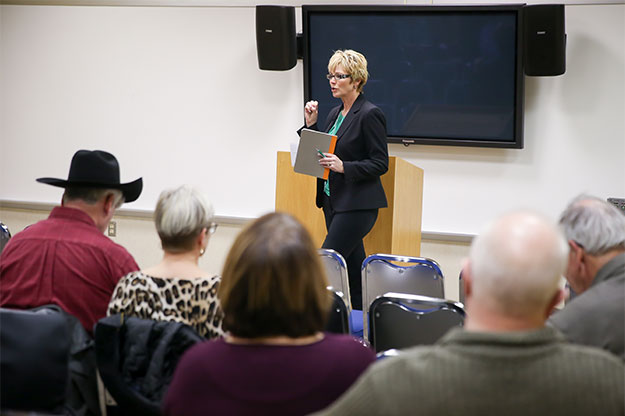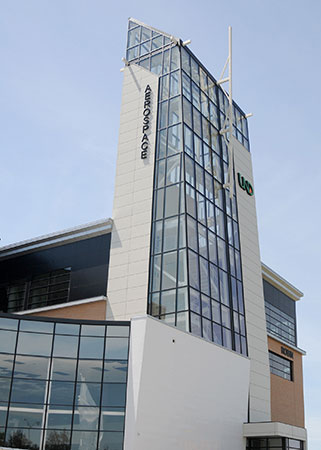Meeting the challenge
UND leverages North Dakota Higher Education Challenge Fund matching grants for donor support and expanded student experiences

University of North Dakota College of Engineering and Mines Dean Hesham El-Rewini stood in front of a capital campaign steering committee to pitch a big idea — an idea for which he had no money and no name.
“That night I called it the Collaborative Energy Complex (CEC) as a placeholder so I could get the presentation out of the way and then change it later,” El-Rewini smiled, recalling the moment from Sept. 30, 2011. “But it never changed.”
Little more than five years later, students are bustling through the halls for their first semester of classes in the $15.5 million building, which was dedicated in October. To get from zero dollars to the sum needed for the CEC took fundraising — and some help from North Dakota’s Higher Education Challenge Fund.
“With fundraising, sometimes you need a leading gift or a matching program to push the campaign,” El-Rewini said. “People want to give to strong entities that they’re passionate about, and they want to know that somebody else is giving with them, especially if that somebody is a public entity.”

Enter, Challenge Fund
The Challenge Fund was established in the 2013 legislative session, driven by a case made by UND on behalf of all of the state’s higher education institutions with the help of former North Dakota Lt. Gov. Drew Wrigley and other supporters. The fund provides $1 in matching grant money for every $2 raised by a university through private donors. That money could be used for projects, programs and scholarships that advance student learning.
DeAnna Carlson Zink, CEO of the UND Alumni Association and Foundation, says the success of the program is in the numbers. Over the last two biennia, UND has received $16.5 million in grant money to match an estimated $33 million raised in private funds, creating a $49 million impact on students at UND alone.
“That’s important when you’re talking about endowed scholarship programs, endowed faculty and endowed programs. That’s important for our students to get the best education possible,” Carlson Zink said.
As North Dakota’s legislators head into another difficult session, a matching grant program like the Challenge Fund will become crucial. University leaders agree that to deal with smaller state budgets, they have to rely more on philanthropy.
“States realize that even when the budget is crunched, when they offer matching grants, they are in a way bringing more resources into the state,” El-Rewini said. “So it would be a mistake to hinder that program.”
Escalating awareness

In the first biennium of the program, Challenge Fund money could be used for new campus building projects, an application that was removed when the fund was renewed in the 2015 legislative session. During that time, however, UND was able to use the program to leverage donor support for both the CEC and UND Aerospace’s Robin Hall, headquarters for the University’s growing unmanned aircraft systems (UAS) programs.
“Robin Hall is, in part, a conduit to help escalate awareness and fast-track the progress of the UAS program,” said UND Aerospace Foundation CEO Chuck Pineo. “With the generosity of these donors and the state, it definitely shows we’re committing to the world that we’re going to be a leader.”
Pineo says $1.45 million of the nearly $22 million Robin Hall came from the Challenge Fund’s matching dollars. He adds that knowing the match was available boosted donor buy-in.
“Someone may be looking at giving you $100,000, but if they see a match could be involved, they may up it,” Pineo explained. “Or they may be more comfortable giving because they see other people involved.”
Pineo also pointed to state support as a reason many benefactors from outside the region chose to help champion the project.
“The fact that they pay attention to Grand Forks is because they see the commitment from our congressional delegation, from our University officials, from our state legislature and from our governor,” Pineo said. “And when they come to town, they have access to all of that, and they can see that this is something that’s important and that the project is a priority.”
Best and brightest
Now that the CEC is complete, El-Rewini is shifting his use of the Challenge Fund from infrastructure to the next generation of people filling the building. He says matched scholarship money would bring in the best and the brightest.
“When they are here, they develop partnerships here. They end up working here, they build companies here, they marry from here,” he said. “Having the matching fund available will help me expedite achieving my goal: getting more money for scholarships and endowed professorships so we can get the University and the state to the next level.”
In the 2015-2017 biennium, UND received $6.5 million from the Challenge Fund to match the $13 million it raised from private donors. The focus of much of those dollars has been student scholarships.
“That’s been a highlight for the University across the board. Every college has been able to benefit from it,” Carlson Zink said. “Any time you can lower the debt for students today, I think that’s vital.”


